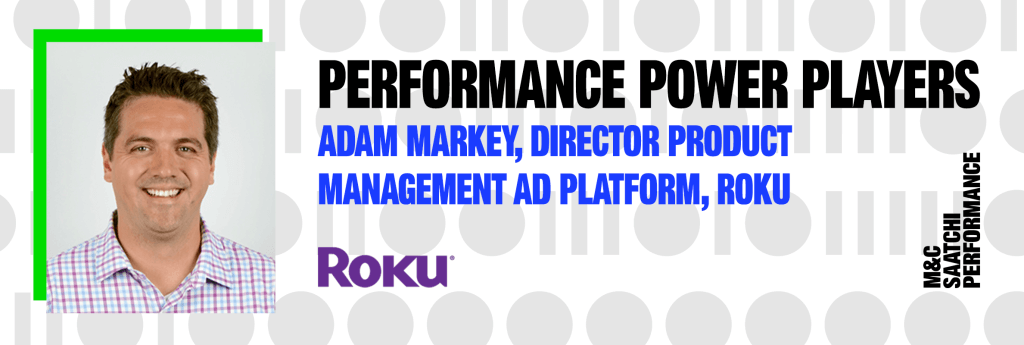Performance Power Players: Adam Markey, Roku

Roku’s Adam Markey Speaks on an exciting future for CTV Advertising
Adam Markey is the Director of Product Management at Roku, a pioneer in all things streaming TV. His work is focused on the Roku Ad Platform, which makes Adam the perfect person to weigh in on the state of streaming TV advertising today. We sat down with Adam to learn how Roku is helping build the broader streaming TV ecosystem, discuss how marketers can adapt to include CTV in their big-picture ad strategies, and anticipate what’s coming down the road for TV advertising’s future.
Key takeaways:
- CTV advertising contributes to the full customer conversion funnel. Marketers that use search and social ads should consider streaming TV as another performance marketing channel
- Winning ads on streaming services have three crucial ingredients: content, context, and creative. Creative is especially key — but beyond visuals, advertisers should investigate options like shoppable ad units.
- We’re early in the game for CTV advertising. Expect major innovation around ads on streaming tv, measurement, and targeting. In the future, when all TV will be streamed.
Roku plays a multi-faceted role in the CTV ecosystem. What factors have shaped your trajectory?
Connected TV is evolving rapidly, and consumer behavior is the driving force behind that evolution. We want to make TV Streaming better for everyone, key components to that are helping people find the content they want, making access frictionless, and providing value to them. Access has two components — usability, and financial feasibility. Streaming TV providers need to address usability issues by designing approachable UIs and accounting for nuances in the user experience. We also unlock better access for consumers through unpaid options. One of our most searched keywords is “free” — we take that as a signal that our customers want to watch great content, but not necessarily pay for another subscription to do so. A better TV experience provides value to people wherever they are in a way that doesn’t hinder the core TV watching experience. With an ad-supported model, streaming TV providers can make better content available to everyone.
From a marketer’s perspective, is there any difference between advertising on a purpose-built smart TV vs. one powered by an external device (e.g. Roku, Apple TV, Firestick, etc.)?
With a smart TV OS like Roku we can more easily provide a frictionless and valuable experience. Purpose-built smart TVs have the ability to accept other devices through inputs like HDMI. HDMI powers more traditional media through gaming consoles, cable boxes, and other streaming TV boxes. Overall they deliver a more integrated consumer experience while giving advertisers more control over how their content is delivered.
For example, Roku smart TVs use automatic content recognition (ACR) technology to power better consumer experiences like our “more ways to watch” feature, support Dynamic Linear Ads which replaces live, linear ads with streaming ads thanks to our acquisition of Nielsen AVA, and enable advertising use cases like incremental reach targeting and measurement.
As TV streaming V hours watched has now taken over linear TV in hours watched, it’s important that linear can always be taken into account when running a TV streaming campaign. With ACR data we can model the entire streaming buy (even on external devices and other operating systems) to provide the marketer with a complete picture of how Streaming is incremental and complementary to linear. Our OneView ad platform does this natively for all streaming campaigns, even outside of the Roku universe, today without the need for other measurement tools or additional fees. We’re able to provide this value to marketers because we own the ACR technology.
How has the advent of dedicated streaming TV ad platforms changed the game for advertisers?
Typically, TV streaming platforms give buyers access to multiple supply partners in a single interface. For instance, OneView by Roku, the ad platform built for TV streaming lets advertisers maximize outcomes across all of their publishers, not just The Roku Channel. Our most sophisticated TV buyers bring their upfronts to the platform, optimize reach within that on top of their linear buy (through ACR), and when they have additional scatter budgets, they use those to maximize incremental reach on top of both their guaranteed upfronts and their linear universe.
Dedicated TV streaming platforms also offer advanced reporting. On OneView, advertisers can see things like cost-per-unique reach, exclusive reach, and whether or not a publisher is helping with their frequency goals, all measured against their target audience. This type of thinking is new to TV buyers who have traditionally been tied down to metrics like GRPs and TRPs. We share these insights across all publishers where we can, and we can also pair brand studies to see how these tactics impact brand sentiment.
In addition to that, for buyers looking to drive return on ad spend and incremental purchase lift, we have a whole new growth segment of customers that use our performance optimization and incrementality to realize business outcomes through TV streaming. Growth marketers and represent a new way of thinking about TV.
What are the pros and cons of direct partnerships over programmatic streaming TV?
Depending on the partner, a direct engagement will get you lower media cost, reliable performance, customer support, and sometimes unique insights from owned media. When a streaming buy goes programmatic, there’s an ability to do you can often layer on optimization capabilities, more complete frequency management, streaming data, ACR data, and insights to your entire TV streaming buy, and then pair it with omni-channel media to power the whole customer journey. With programmatic there will be tech fees involved, but a great platform will be able to articulate the value back to you. For instance, we’ve proven that spending $2 Million in individual guarantees, vs $2 Million in a programmatic campaign can net an additional 4 million households reached while still maintaining guarantees with those publishers. In either case, a strong streaming TV partner will be able to control reach and frequency as well as optimize toward real business outcomes wherever you are purchasing media.
Can you share any high-level insights from the Roku Brand Studio? What are some easy adjustments advertisers can make to ensure creative is impactful on CTV?
Great performance in TV streaming is a three-legged stool of content, context, and creative. Without great creative, campaigns cannot perform. Our Roku brand studio team enables marketers to build great creatives that integrate into content to create the most impactful brand moments possible, as well as interactive units that can drive performance. For example, “The Short List,” in partnership with Reese Witherspoon’s Hello Sunshine, will bring brands into 12 short-form films across four genres — Drama, Comedy, Documentary, and Animation — all created by the most promising and diverse new minds in entertainment.
Shoppable ads are also an exciting new capability some CTV advertising platforms offer. We are able to power these ad units through our recent exclusive retailer partnership with Walmart. Just by pressing the “OK” button on your remote, you can purchase something related to that ad right from your TV. Ad format innovations like this are only possible when you can control the experience from end to end. In our research, we’ve found that purchasing this way yields much higher performance in the long run compared to putting a QR code in an app.
How are new consumer privacy policies affecting CTV? Are tracking tools like the ACR footprint and cross-device attribution here to stay?
ACR and cross-device attribution will remain for those platforms that have relationships with their customers directly. More and more, consumers can decide not to share their information with these third-party platforms. It only makes sense that advertisers with direct customer relationships should choose platforms, publishers, and technologies that also have those relationships to ensure accuracy and performance in their media buys.
Do you have any predictions for the future of CTV?
We believe that all TV ads will be streamed. For the first time this year, streaming has taken over linear in terms of hours. TV streaming should be at the heart of every media plan. We’re building toward a world where traditional upfronts and scatter will be automated and work together to give marketers the best outcomes. Brands will do less CTV advertising via direct insertion orders and more through programmatic automation. The exciting part is that we’re really just at the beginning in terms of knowing how advertisers will use this technology. There are huge changes still to come in ad experiences, measurement, identity, and targeting. It’s an exciting time.
Thanks for chatting with us, Adam!
About Adam Markey
Adam Markey joined Roku as Director of Product Management, Ad Platform in 2019, after almost a decade in leading product management roles with DataXu. He’s been called the “Corvette of AdTech PMs,” tipping a hat to his career at the vanguard of programmatic ad tech. From pioneering RTB technology to his leadership around the first DSP for streaming, Adam Markey is an undeniable leader in the space and a driving force in CTV advertising technology.
Interested in becoming a Performance Power Player? Contact us if you would like to be considered as a contributor to our blog. For more about our streaming tv advertising services click here.


